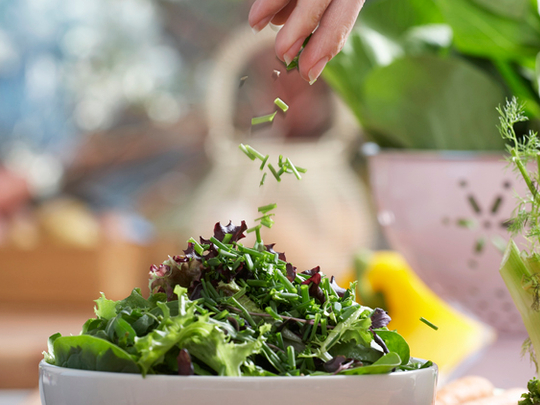
With its fridge and cupboards full of tempting treats, sometimes the kitchen can seem like a dangerous place to be when you're trying to lose weight. However, with a few subtle kitchen changes you can equip yourself for better diet success. Here are our top 10 kitchen tips to help you stay slim.
1. Keep healthy foods visible...
A study by researchers at Cornell University found that we are three times more likely to eat the first item we see in the kitchen than the fifth, meaning that keeping healthy food visible could aid your dieting goals. Try to make healthy food options more accessible by ensuring they are as appealing and convenient as possible, as well as making them visible and easy to find. Leave out a colourful fruit bowl, prepare a salad in advance, and put some chopped veggies at the front of your fridge, for example.
2. ... And move ‘bad’ foods out of sight
Just as putting healthy foods in a prominent position can help your diet, it follows that the opposite is also true. While it may be best to avoid buying junk food completely, if you must stock up on the odd treat make sure they are hidden away at the back of cupboards to help prevent cravings. By making these foods a little more difficult to get to (store them behind piles of tins, in high cupboards or in locked drawers – whatever helps), you will also prevent mindless snacking and give yourself some thinking time to decide whether you really want to give in to temptation.
3. Get some fridge-spiration
To help stay motivated in the face of your cravings, try transforming your fridge from a source of temptation into an inspirational reminder of your progress so far. Consider sticking your favourite photograph of yourself on your fridge for a positive reminder of why you should resist those cravings next time you’re tempted to hit the fridge. Alternatively, stick on a motivational quote or a handwritten note to yourself listing five good reasons not to binge.
4. Opt for small, blue serving dishes
While many of us think we are eating standard portion sizes, this is in fact not always the case. To help reduce your temptation to overeat, try swapping your plates, bowls, glasses and cutlery for smaller ones, which will help control your serving sizes as well as how quickly you eat. Also, while you are making the switch, think about opting for a blue colour scheme for your crockery, as blue is thought to act as an appetite suppressant.
5. Set aside an eating area
Whether you eat your meals in the kitchen or a separate dining room, it is important to set aside an area with a table where you can sit down and eat. Furthermore, it is important to ensure you actually sit there. Make it a rule never to eat out of packets or standing up and you will find that this drastically reduces your tendency to overeat. The process of putting food on a plate and sitting down to eat it not only reduces the tendency to mindlessly pick at food, it also increases your awareness of what – and how much – you are eating, and may make you think twice about doing it.
6. Keep your kitchen tidy
If you’re lacking motivation to cook, it may be that your kitchen’s to blame. Cluttered worktops and messy cupboards hardly act as an incentive to start whipping up a gourmet delight so, if you have to clear a path to the oven or forge through piles of half-opened packets of food to get to what you want, it may be time to give your kitchen a makeover. Treat your kitchen as a place for food preparation – rather than a rubbish dump, mailroom or storage space – and you may be more inspired to reach for the wooden spoon rather than a takeaway menu the next time hunger strikes.
7. Impose a TV ban
If you’re one of the large number of people who prefers to eat their meals in front of a TV or computer screen, then you could be sabotaging your diet without even realising it. According to research findings published in the British Journal of Nutrition, eating when distracted can cause you to ignore signals from your body that you’ve had enough, leading you to eat more than you normally would. To help cut your calorie intake, make sure you keep distracting items such as the television out of your eating area, and try to keep the two activities separate.
8. Set kitchen “closing hours”
To help cut the amount of food you are consuming, it is helpful to make the kitchen out-of-bounds once you have finished your evening meal. Move anything you may need during those hours out of the kitchen (and no, this doesn’t include chocolate!), then turn off the light and close the door as a reminder to yourself that the kitchen is now closed. While you will still need to rely on your own willpower to stick to these rules, this should help reduce mindless snacking and trips to the kitchen next time you’re feeling bored.
9. Spice up your kitchen
Your cupboards and fridge may be packed with healthy items, but how’s your spice rack looking? You might not class it as a kitchen essential, but if you’re looking to cut calories in your meals it can help to keep a well-stocked herb and spice rack. Not only does adding herbs and seasonings to your meals add flavouring to your food without extra calories, but spices such as cinnamon, cayenne, black pepper and ginger can actually help promote weight loss.
10. Kill your cravings with vanilla
If you struggle to resist sugar cravings following your evening meal, it may be worth investing in a vanilla-scented air freshener or candle for your kitchen. A study at St George’s hospital, south London, found that using vanilla-scented patches on the back of participants’ hands significantly reduced their appetite for sweet foods and drinks. It is thought that this is due to the smell of vanilla, which is believed to help suppress sweet cravings.
Related articles from realbuzz.com
How to create a healthier home
Coping with food cravings











